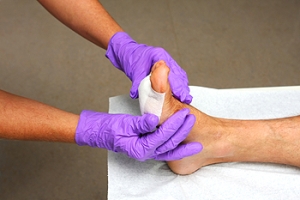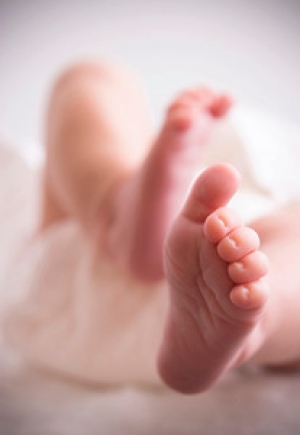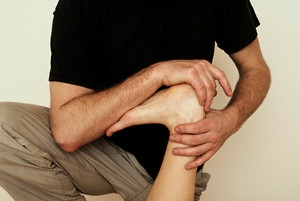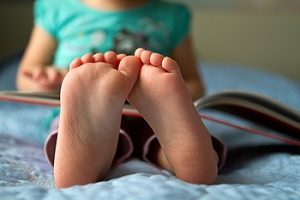
Diabetes and Wound Care
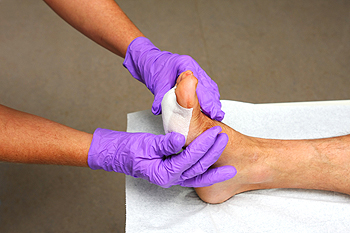 It’s important for most people to check their feet frequently for abnormal conditions, and this is especially true for diabetic patients. If cuts, scrapes and blisters are not noticed, the chances of developing an infection may be amplified because of the body’s inability to heal efficiently. If there are wounds on the feet, recent research has shown the importance of resting frequently, which takes pressure off of the affected area. If you notice cuts on your feet and ankles, it’s suggested to consult with a podiatrist as quickly as possible. At this time a treatment plan can be discussed, which may include what type of wound dressing to use and how often it should be changed. It may be helpful to the patient and may aid in the healing process if the blood sugar levels can be controlled by maintaining a healthy diet and gentle exercise plan.
It’s important for most people to check their feet frequently for abnormal conditions, and this is especially true for diabetic patients. If cuts, scrapes and blisters are not noticed, the chances of developing an infection may be amplified because of the body’s inability to heal efficiently. If there are wounds on the feet, recent research has shown the importance of resting frequently, which takes pressure off of the affected area. If you notice cuts on your feet and ankles, it’s suggested to consult with a podiatrist as quickly as possible. At this time a treatment plan can be discussed, which may include what type of wound dressing to use and how often it should be changed. It may be helpful to the patient and may aid in the healing process if the blood sugar levels can be controlled by maintaining a healthy diet and gentle exercise plan.
Wound care is an important part in dealing with diabetes. If you have diabetes and a foot wound or would like more information about wound care for diabetics, consult with James P. Huish, DPM from Arizona. Our doctors will assess your condition and provide you with quality foot and ankle treatment.
What Is Wound Care?
Wound care is the practice of taking proper care of a wound. This can range from the smallest to the largest of wounds. While everyone can benefit from proper wound care, it is much more important for diabetics. Diabetics often suffer from poor blood circulation which causes wounds to heal much slower than they would in a non-diabetic.
What Is the Importance of Wound Care?
While it may not seem apparent with small ulcers on the foot, for diabetics, any size ulcer can become infected. Diabetics often also suffer from neuropathy, or nerve loss. This means they might not even feel when they have an ulcer on their foot. If the wound becomes severely infected, amputation may be necessary. Therefore, it is of the upmost importance to properly care for any and all foot wounds.
How to Care for Wounds
The best way to care for foot wounds is to prevent them. For diabetics, this means daily inspections of the feet for any signs of abnormalities or ulcers. It is also recommended to see a podiatrist several times a year for a foot inspection. If you do have an ulcer, run the wound under water to clear dirt from the wound; then apply antibiotic ointment to the wound and cover with a bandage. Bandages should be changed daily and keeping pressure off the wound is smart. It is advised to see a podiatrist, who can keep an eye on it.
If you have any questions, please feel free to contact our office located in Safford and Sierra Vista, AZ . We offer the newest diagnostic and treatment technologies for all your foot care needs.
Wound Care
Diabetics must be wary of all wounds, regardless of depth or size. Diabetes, a chronic disease in which the body cannot properly use glucose the way it normally would, causes various complications that make wounds difficult to heal. Nerve damage or neuropathy will cause diabetics to have trouble feeling the pain of a blister or cut until the condition has significantly worsened or become infected. A diabetic’s weakened immune system can make even the most minor of wounds easily susceptible to infection. Diabetics are also more prone to developing narrow, clogged arteries, and are therefore more likely to develop wounds.
Wounds should be taken care of immediately after discovery, as even the smallest of wounds can become infected if enough bacteria build up within the wound. To remove dirt, wounds should be first rinsed under running water only. Soap, hydrogen peroxide, or iodine can irritate the injury and should be avoided. To prevent infection, apply antibiotic ointment to the wound and cover it with a bandage. The bandage should be changed daily. The skin around the wound may be cleaned with soap.
To prevent further exacerbation, see a doctor—especially if you have diabetes. Minor skin conditions can become larger problems if not properly inspected. As the wound heals, make sure to avoid applying pressure to the affected area.
Pregnancy and Oedema
 One of the most common ailments pregnant women notice is the onset of swelling in their feet and ankles. This condition is referred to as oedema, and research has shown that it generally affects between fifty to eighty percent of healthy pregnant women. This may typically be a result of the excess pressure the growing fetus exerts on the blood vessels surrounding the pelvis. The circulation process may become slower because of the additional fluid that is retained, and the feet and ankles may be affected by this. Many women have found effective ways to maintain comfort during their pregnancies, including elevating their feet as often possible, avoiding standing for extended periods of time, and performing gentle exercises on a regular basis. Some women have found that wearing compression stockings may aid in reducing a portion of the swelling. If you would like additional information about how pregnancy can affect your feet, it’s suggested to speak with a podiatrist.
One of the most common ailments pregnant women notice is the onset of swelling in their feet and ankles. This condition is referred to as oedema, and research has shown that it generally affects between fifty to eighty percent of healthy pregnant women. This may typically be a result of the excess pressure the growing fetus exerts on the blood vessels surrounding the pelvis. The circulation process may become slower because of the additional fluid that is retained, and the feet and ankles may be affected by this. Many women have found effective ways to maintain comfort during their pregnancies, including elevating their feet as often possible, avoiding standing for extended periods of time, and performing gentle exercises on a regular basis. Some women have found that wearing compression stockings may aid in reducing a portion of the swelling. If you would like additional information about how pregnancy can affect your feet, it’s suggested to speak with a podiatrist.
Pregnant women with swollen feet can be treated with a variety of different methods that are readily available. For more information about other cures for swollen feet during pregnancy, consult with James P. Huish, DPM from Arizona. Our doctors will attend to all of your foot and ankle needs.
What Foot Problems Can Arise During Pregnancy?
One problem that can occur is overpronation, which occurs when the arch of the foot flattens and tends to roll inward. This can cause pain and discomfort in your heels while you’re walking or even just standing up, trying to support your baby.
Another problem is edema, or swelling in the extremities. This often affects the feet during pregnancy but tends to occur in the later stages.
How Can I Keep My Feet Healthy During Pregnancy?
- Wearing orthotics can provide extra support for the feet and help distribute weight evenly
- Minimize the amount of time spent walking barefoot
- Wear shoes with good arch support
- Wear shoes that allow for good circulation to the feet
- Elevate feet if you experience swelling
- Massage your feet
- Get regular, light exercise, such as walking, to promote blood circulation to the feet
If you have any questions please feel free to contact our office located in Safford and Sierra Vista, AZ . We offer the newest diagnostic and treatment technologies for all your foot and ankle needs.
Foot Care for Pregnant Women
The natural weight that pregnant women gain causes their center of gravity to be completely altered. This causes them to have a new weight-bearing stance which adds pressure to the knees and feet. As a result, pregnant women often experience severe foot pain. The two most common foot issues experienced by women in their pregnancies are edema and over-pronation. It is important for all pregnant women to learn more about how to take care of their feet so they are more comfortable during their pregnancy.
Over-pronation, which is commonly referred to as flat feet, is caused when a person’s arch flattens out upon weight bearing. This causes the person’s feet to roll inward while walking. Pregnant women often experience this due to the sudden weight they gain.
Edema, also referred as swelling in the feet, typically occurs in the later part of the pregnancy. It is the result of the extra blood accumulated in the pregnant woman’s body. The enlarged uterus puts more pressure on the blood vessels in the pelvis which causes leg circulation to slow down. This causes blood to pool in the lower extremities.
Fortunately, there are ways to treat both edema and over-pronation. Edema can be treated by elevating the foot as often as possible. Wearing proper fitting footwear will also be helpful for those with edema. A treatment method for over-pronation could be orthotics. Orthotic inserts should be designed with appropriate arch support and medial rear foot for your foot.
It is best for pregnant women to buy new shoes during the day, because this is the time where swelling is at its peak. Pregnant women also shouldn’t rush when buying shoes. It is always advised that you make sure your shoes fit properly but this is especially important during pregnancy.
If you are a pregnant woman, you should consult with a podiatrist in order to make sure your feet are healthy throughout the entirety of your pregnancy.
How to Prevent Common Foot Ailments in Children
 The importance of keeping your child’s feet healthy is crucial in possibly preventing potential foot problems later in life. There are simple tasks that can be accomplished daily that will promote healthy feet and may positively affect the overall health of the body. These may include washing and drying the feet daily, which may aid in avoiding athlete's foot from developing, in additional to choosing comfortable socks and shoes to wear. Research has shown that if shoes, which are worn have become too tight, bunions may develop if there is a pre-existing case present. This is known to be a painful condition in which a hard, bony growth develops on the side of the big toe and will typically make it necessary to wear larger size shoes that can accommodate the bunion. If you would like additional information about how to keep your child's feet healthy, it is recommended that you speak to a podiatrist who can provide the proper answers to your questions.
The importance of keeping your child’s feet healthy is crucial in possibly preventing potential foot problems later in life. There are simple tasks that can be accomplished daily that will promote healthy feet and may positively affect the overall health of the body. These may include washing and drying the feet daily, which may aid in avoiding athlete's foot from developing, in additional to choosing comfortable socks and shoes to wear. Research has shown that if shoes, which are worn have become too tight, bunions may develop if there is a pre-existing case present. This is known to be a painful condition in which a hard, bony growth develops on the side of the big toe and will typically make it necessary to wear larger size shoes that can accommodate the bunion. If you would like additional information about how to keep your child's feet healthy, it is recommended that you speak to a podiatrist who can provide the proper answers to your questions.
Making sure that your children maintain good foot health is very important as they grow. If you have any questions, contact James P. Huish, DPM of Arizona. Our doctors can provide the care you need to keep you pain-free and on your feet.
Keeping Children's Feet Healthy
Having healthy feet during childhood can help prevent medical problems later in life, namely in the back and legs. As children grow, their feet require different types of care. Here are some things to consider...
Although babies do not walk yet, it is still very important to take care of their feet.
Avoid putting tight shoes or socks on his or her feet.
Allow the baby to stretch and kick his or her feet to feel comfortable.
As a toddler, kids are now on the move and begin to develop differently. At this age, toddlers are getting a feel for walking, so don’t be alarmed if your toddler is unsteady or ‘walks funny’.
As your child gets older, it is important to teach them how to take care of their feet.
Show them proper hygiene to prevent infections such as fungus.
Be watchful for any pain or injury.
Have all injuries checked by a doctor as soon as possible.
Comfortable, protective shoes should always be worn, especially at play.
If you have any questions please feel free to contact our office located in Safford and Sierra Vista, AZ . We offer the newest diagnostic and treatment technologies for all your foot and ankle needs.
How to Care for Your Child's Feet
It is never normal for a child to experience pain in his or her feet. Foot pain that lasts more than a few days and limits a child’s ability to walk should be examined by a podiatrist. Many adult foot ailments originate in childhood and may be present at birth. Common foot issues that are experienced by children are pediatric flat foot, Sever’s disease, ingrown toenails, and plantar warts.
A child’s foot grows rapidly during the first year, allowing it to reach almost half of their adult foot size. Consequently, foot specialists consider the first year to be the most crucial point in the foot development process. There are ways you can help ensure that your child’s foot develops properly. One way is to carefully look at your baby’s feet. If you notice any deformities, you should immediately seek professional care. You should also loosely cover your child’s foot, since tight coverings may prevent movement and inhibit normal development. Another tip is to change the baby’s positioning throughout the day. If your baby lies down in one spot for too long, it may put an excess amount of strain on the feet and legs.
It is best that you try not to force a child to start walking. Children will begin to walk when they are both physically and emotionally capable to do so. You should also avoid comparing your child’s walking progress with other children because the age range for independent walking may range. When your child’s feet begin to develop, you may need to change both their shoe and sock size every few months to allow room for their feet to grow.
Kids are sometimes prone to splinters, cuts, and severe injuries because they tend to walk around barefoot. This also makes them more susceptible to developing plantar warts which is a condition caused by a virus that invades the sole of the foot through breaks in the skin. These ailments can be avoided by making sure your child wears shoes in unsanitary environments. You should also wash any minor cuts or scrapes on your child’s feet. It is a myth that exposure to fresh air will heal injuries; fresh air will only expose your child’s cuts to germs.
As a parent, you should ensure that your child’s feet are developing properly and are being properly maintained. Consequently, it is important that you perform routine inspections on his or her feet to detect any injuries or deformities in their early stages. Early detection and treatment will help to ensure that your child does not develop any serious foot conditions.
Specific Foot Stretches May Help Plantar Fasciitis
 A common foot condition that is known as plantar fasciitis may produce severe pain and discomfort in some patients. It is defined as an inflammation of the plantar fascia and this is the tissue that is located on the bottom of the foot and connects the heel to the toes. The pain is generally felt in the heel of the foot, and it may tend to make daily activities that require mobility difficult to perform. Research has shown calf muscles, which are tight may possibly contribute to the discomfort plantar fasciitis may generate. There are specific stretches that can be practiced, which may aid in achieving a moderate level of relief. These may include standing with your palms flat against a wall while bending one leg forward and keeping the other leg straight while the the heel lies flat on the floor. This stretch can be held for several seconds, then repeated on the opposite side. Additionally, the plantar fascia may be adequately stretched while rolling your foot on a tennis ball, a foam roller, or a frozen water bottle. If you are afflicted with plantar fasciitis, it is advised to seek the counsel of a podiatrist who can properly treat this condition.
A common foot condition that is known as plantar fasciitis may produce severe pain and discomfort in some patients. It is defined as an inflammation of the plantar fascia and this is the tissue that is located on the bottom of the foot and connects the heel to the toes. The pain is generally felt in the heel of the foot, and it may tend to make daily activities that require mobility difficult to perform. Research has shown calf muscles, which are tight may possibly contribute to the discomfort plantar fasciitis may generate. There are specific stretches that can be practiced, which may aid in achieving a moderate level of relief. These may include standing with your palms flat against a wall while bending one leg forward and keeping the other leg straight while the the heel lies flat on the floor. This stretch can be held for several seconds, then repeated on the opposite side. Additionally, the plantar fascia may be adequately stretched while rolling your foot on a tennis ball, a foam roller, or a frozen water bottle. If you are afflicted with plantar fasciitis, it is advised to seek the counsel of a podiatrist who can properly treat this condition.
Stretching the feet is a great way to prevent injuries. If you have any concerns with your feet consult with James P. Huish, DPM from Arizona. Our doctors will assess your condition and provide you with quality foot and ankle treatment.
Stretching the Feet
Stretching the muscles in the foot is an important part in any physical activity. Feet that are tight can lead to less flexibility and make you more prone to injury. One of the most common forms of foot pain, plantar fasciitis, can be stretched out to help ease the pain. Stretching can not only ease pain from plantar fasciitis but also prevent it as well. However, it is important to see a podiatrist first if stretching is right for you. Podiatrists can also recommend other ways to stretch your feet. Once you know whether stretching is right for you, here are some excellent stretches you can do.
- Using a foam roller or any cylindrical object (a water bottle or soda can will do), roll the object under your foot back and forth. You should also exert pressure on the object. Be sure to do this to both feet for a minute. Do this exercise three times each.
- Similar to the previous one, take a ball, such as a tennis ball, and roll it under your foot while seated and exert pressure on it.
- Grab a resistance band or towel and take a seat. If you are using a towel, fold it length wise. Next put either one between the ball of your foot and heel and pull with both hands on each side towards you. Hold this for 15 seconds and then switch feet. Do this three times for each foot.
- Finally hold your big toe while crossing one leg over the other. Pull the toe towards you and hold for 15 seconds. Once again do this three times per foot.
It is best to go easy when first stretching your foot and work your way up. If your foot starts hurting, stop exercising and ice and rest the foot. It is advised to then see a podiatrist for help.
If you have any questions, please feel free to contact our office located in Safford and Sierra Vista, AZ . We offer the newest diagnostic and treatment technologies for all your foot care needs.
How to Stretch Your Feet
Your feet endure a great amount of stress each day from constantly allowing us to move around. It is important to stretch your feet to help prevent them from becoming injured. Your toes may easily deform into unhealthful positions if they are not stretched.
One of the most common reasons for toe deformities are the shoes you may be wearing. Shoes that are too tight may fold and shift the toes out of place. Heeled shoes may also push your toes upward. Forcing your toes into an unnatural position which may cause the muscles to tighten and prevent them from reverting to normal length. Another common reason is improper use of foot muscles. Many people fail to use the muscles in their feet or toes when they walk. Lastly, the positioning of your feet while walking may also cause toe deformities. If you walk with your feet facing outward, your “push-off” phase is on the side of your big toe instead of the bottom of your foot. This may cause the big toe to eventually tighten into a new shifted position.
There are many reasons why stretching your toes may be helpful. One reason is that healthy spacing may aid in avoiding calluses and other injuries that are caused by rubbing. Stretching will also prevent you from developing toes that curl, hammertoes, or bunions.
A great way to stretch your toes is to place them in your hands and bend them all downward; this will help you stretch the top of your foot. Next, you should repeat this process but instead bend them upward enough to feel a nice stretch in the bottom of your foot. You should then try to pull each toe apart from the next and pull any toes that are bent upward until they are back downward.
If you are looking to practice stretching your entire foot, you can try a towel stretch. This is done by sitting on the floor with your legs in front of you. Take a towel and wrap it around your toes. Afterward, pull the towel toward you with your toes and hold this position for 15 to 30 seconds before releasing. Practice this stretch for three sets. Another stretch your feet are towel lifts. This is done by sitting in a chair and trying to pick a towel up from the ground with your toes. Try lifting the towel with your little toes for five sets before switching feet.
If you are an athlete, or exercise often, it is especially important for you to practice stretching your feet. Those who suffer from foot pain caused by poor footwear, plantar fasciitis, or long hours of standing at work may also benefit from foot exercises.
Helping Your Child with Sever’s Disease
 Sever’s disease is a common ailment that many younger children face. It affects open growth plates in the heel of the foot and usually strikes between the ages of 8 and 14, but the development can vary depending on the child. Some symptoms to look for are foot or heel pain and difficulty in walking. Some children only feel slight discomfort while others may develop a limp due to intense pain. Sports are one of the main causes for this disease, because frequent physical activity irritates the growth plate. Oftentimes, participating in sports year-round will trigger this discomfort, because the growing bones don’t have time to fully recover. Sometimes all the foot needs is a break from physical activity to heal itself. If you think your child may be suffering from Sever’s disease, it is strongly recommended that you consult with a podiatrist in order to properly treat their pain.
Sever’s disease is a common ailment that many younger children face. It affects open growth plates in the heel of the foot and usually strikes between the ages of 8 and 14, but the development can vary depending on the child. Some symptoms to look for are foot or heel pain and difficulty in walking. Some children only feel slight discomfort while others may develop a limp due to intense pain. Sports are one of the main causes for this disease, because frequent physical activity irritates the growth plate. Oftentimes, participating in sports year-round will trigger this discomfort, because the growing bones don’t have time to fully recover. Sometimes all the foot needs is a break from physical activity to heal itself. If you think your child may be suffering from Sever’s disease, it is strongly recommended that you consult with a podiatrist in order to properly treat their pain.
Sever's disease often occurs in children and teens. If your child is experiencing foot or ankle pain, see James P. Huish, DPM from Arizona. Our doctors can treat your child’s foot and ankle needs.
Sever’s Disease
Sever’s disease is also known as calcaneal apophysitis, which is a medical condition that causes heel pain I none or both feet. The disease is known to affect children between the ages of 8 and 14.
Sever’s disease occurs when part of the child’s heel known as the growth plate (calcaneal epiphysis) is attached to the Achilles tendon. This area can suffer injury when the muscles and tendons of the growing foot do not keep pace with bone growth. Therefore, the constant pain which one experiences at the back of the heel will make the child unable to put any weight on the heel. The child is then forced to walk on their toes.
Symptoms
Acute pain – Pain associated with Sever’s disease is usually felt in the heel when the child engages in physical activity such as walking, jumping and or running.
Highly active – Children who are very active are among the most susceptible in experiencing Sever’s disease, because of the stress and tension placed on their feet.
If you have any questions, please feel free to contact our office located in Safford and Sierra Vista, AZ . We offer the newest diagnostic and treatment technologies for all your foot and ankle injuries.
Sever's Disease
Sever’s disease, also known as calcaneal apophysitis is a common bone disorder that occurs during childhood. The disease is defined as an inflammation of the growth plate in the heel. When a child has a growth spurt, his heel bone grows faster than the muscles, tendons, and ligaments in his leg. This disease is a result of overuse. The people who are most likely to be affected by this disease are children who are in a growth spurt, especially boys who are from the ages of 5 to 13 years old. 60% of children with Sever’s disease have both heels involved.
Symptoms of this disease are heel pain that intensifies during running and jumping activities. The pain is typically localized to the posterior part of the heel. Symptoms may be severe, and they can easily interfere with daily activities. Children who play soccer, baseball, and basketball are more likely to develop Sever’s disease.
Your doctor will diagnose your child based on his or her symptoms, x-rays are generally not helpful in diagnosing this disease. Your doctor may examine both heels and ask your child questions about his or her activity level in sports. Your doctor may then use the squeeze test on your child’s heel to see if there is any pain. Nevertheless, some doctors might still use x-rays to rule out any other issues such as fractures, infections, and tumors.
Sever’s disease can be prevented by maintaining good flexibility while your child is growing. Another prevention method is to wear good-quality shoes that have firm support and a shock-absorbent sole. Sever’s disease can be treated by ceasing any activity that causes heel pain. You should apply ice to the injured heel for 20 minutes 3 times a day. Additionally, orthotics should be used for children who have high arches, flat feet, or bowed legs.
If you suspect your child has Sever’s disease, you should make an appointment with your podiatrist to have his or her foot examined. Your doctor may recommend nonsteroidal anti-inflammatory drugs (NSAIDs), such as ibuprofen or naproxen to relieve pain. In more severe cases, your child may need a cast to rest his or her heel. Fortunately, Sever’s disease does not cause long-term foot problems. After treatment, your child should start to feel better within two weeks to two months.
